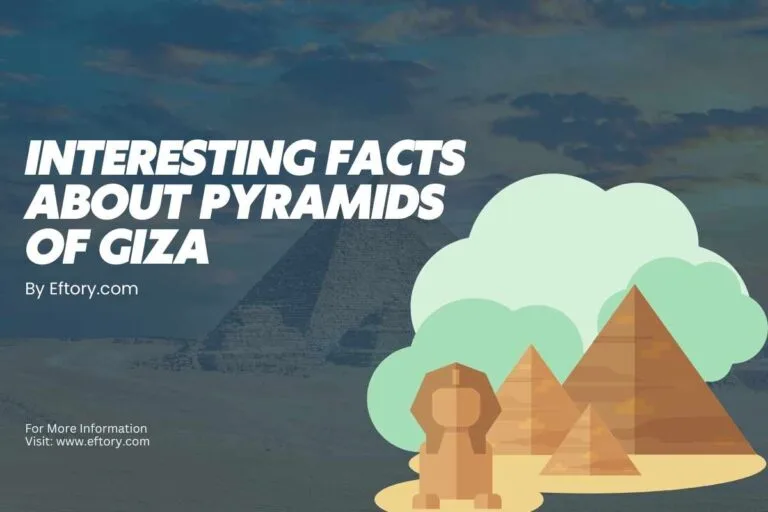The Pyramids of Giza, located on the Giza Plateau near Cairo, Egypt, are among the most iconic & ancient structures in the world. The Pyramids of Giza are three large pyramids built as royal tombs during Egypt’s Old Kingdom period (around 2600–2500 BCE). They were constructed to honor and house the pharaohs after death.
Visitors from around the world come to Giza to see the three main pyramids:
- The Great Pyramid of Khufu (Cheops), the largest and most famous
- The Pyramid of Khafre
- The Pyramid of Menkaure
Top 10 Interesting Facts About Pyramids of Giza
Let’s discuss very little-known facts about the Pyramids of Giza.

1. They Hide Math Secrets Like Pi and the Golden Ratio:
The Great Pyramid’s shape isn’t just random. If you take the total distance around its base and divide it by its height, the number you get is super close to 2π (pi). That’s the same number we use to measure circles. Also, the way the sides are angled matches a famous number in nature and design called the golden ratio (about 1.618). It’s like ancient Egyptians were math wizards, without calculators!
2. The Real Entrance Is 17 Meters High:
The actual entrance to the Great Pyramid is about 17 meters (56 feet) above the ground. But most people don’t go in through that door. Instead, there’s a tunnel dug around 820 AD by a man named Caliph al-Ma’mun, who was searching for treasure. That tunnel is used by tourists today.
3. Queen’s Chamber Has Strange Niches, But No One Knows Why:
Inside the Great Pyramid is a room called the Queen’s Chamber. It has five deep niches in the wall. Experts still don’t know what they were for, maybe to hold statues, maybe for decoration, or maybe for something totally different. It’s still a mystery.
Also Read: Interesting Facts About The Amazon River
4. It Weighs More Than 16 Empire State Buildings:
The Great Pyramid is made up of about 2.3 million blocks, and it weighs nearly 6 million tons. That’s heavier than 16 Empire State Buildings. Each block is super heavy, some weigh as much as a big truck. And they moved all that stone without modern machines.
5. The Pyramids Are Almost Perfectly Aligned:
The sides of the pyramids point exactly north, south, east, and west. That kind of perfect alignment is very hard to do even with modern tools. Historians believe the ancient Egyptians used the stars or the sun’s shadow to get it just right.

6. Scientists Found Hidden Rooms Inside:
In recent years, scientists used a tool called muon scanning (like an X-ray for buildings) and found secret corridors inside the Great Pyramid. These areas hadn’t been seen before and show that there may still be more hidden rooms waiting to be explored.
7. Some Say There’s a City Underground (But Not Everyone Believes It):
Some researchers using radar said they found signs of a giant underground city beneath the pyramids over 6,000 feet long! But many Egyptologists, like Dr. Zahi Hawass, say there’s no strong evidence and that these claims might be wrong or exaggerated.
8. They Weren’t Built by Slaves:
A lot of people think slaves built the pyramids, but that’s not true. Archaeologists have found the workers’ villages, where people lived, cooked, and slept. They were paid workers, well-fed, and likely proud of their job helping the pharaoh.

9. They Used to Shine Like Mirrors:
Long ago, the pyramids were covered in smooth white limestone that reflected sunlight. On a sunny day, they would have glowed brightly, almost like mirrors. Over time, most of that shiny stone was taken off and used for other buildings.
10. They Still Boost Egypt’s Economy Today:
Millions of people visit the pyramids every year, making them one of the most visited tourist spots in the world. Egypt earns a lot of money from tourism. The government is even working on projects like eco-friendly buses and cleaner walkways to protect the area and make visits more enjoyable.
The Pyramids of Giza are important because they show how smart and skilled the ancient Egyptians were. They were built as tombs for pharaohs and hold deep cultural and religious meaning. Today, they are a symbol of Egypt and attract visitors from all over the world.






